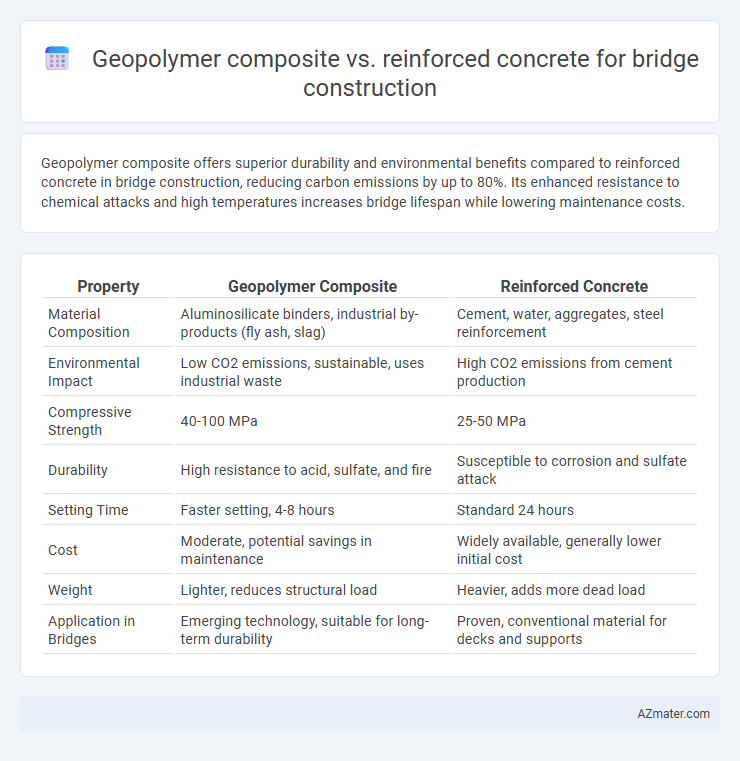Geopolymer composite offers superior durability and environmental benefits compared to reinforced concrete in bridge construction, reducing carbon emissions by up to 80%. Its enhanced resistance to chemical attacks and high temperatures increases bridge lifespan while lowering maintenance costs.
Table of Comparison
| Property | Geopolymer Composite | Reinforced Concrete |
|---|---|---|
| Material Composition | Aluminosilicate binders, industrial by-products (fly ash, slag) | Cement, water, aggregates, steel reinforcement |
| Environmental Impact | Low CO2 emissions, sustainable, uses industrial waste | High CO2 emissions from cement production |
| Compressive Strength | 40-100 MPa | 25-50 MPa |
| Durability | High resistance to acid, sulfate, and fire | Susceptible to corrosion and sulfate attack |
| Setting Time | Faster setting, 4-8 hours | Standard 24 hours |
| Cost | Moderate, potential savings in maintenance | Widely available, generally lower initial cost |
| Weight | Lighter, reduces structural load | Heavier, adds more dead load |
| Application in Bridges | Emerging technology, suitable for long-term durability | Proven, conventional material for decks and supports |
Introduction to Bridge Construction Materials
Geopolymer composites offer a sustainable alternative to reinforced concrete in bridge construction, providing high compressive strength and enhanced resistance to chemical and environmental degradation. Reinforced concrete remains widely used due to its proven durability, versatility, and well-established construction techniques. Advances in geopolymer binders focus on reducing carbon emissions while maintaining structural integrity comparable to traditional cement-based materials.
Overview of Geopolymer Composites
Geopolymer composites are sustainable construction materials synthesized from industrial by-products like fly ash and slag, offering enhanced durability and chemical resistance compared to traditional Portland cement. Their low carbon footprint and excellent mechanical properties make them suitable for bridge construction, especially in aggressive environmental conditions. Geopolymer composites exhibit superior resistance to fire, corrosion, and freeze-thaw cycles, contributing to extended service life and reduced maintenance costs in infrastructure projects.
Fundamentals of Reinforced Concrete
Reinforced concrete combines concrete's compressive strength with steel's tensile strength, making it ideal for bridge construction due to enhanced durability and load-bearing capacity. Geopolymer composites utilize inorganic polymer matrices bonded with aggregates and fibers, offering superior chemical resistance and sustainability by reducing carbon footprint compared to traditional Portland cement concrete. Understanding the fundamentals of reinforced concrete, including the behavior of steel reinforcement within the concrete matrix under stress, is crucial for optimizing bridge design and ensuring long-term structural integrity.
Mechanical Properties Comparison
Geopolymer composites exhibit higher compressive strength and improved alkali resistance compared to traditional reinforced concrete, making them more durable under aggressive environmental conditions. Their low shrinkage and enhanced bond strength with reinforcement materials contribute to better structural integrity and reduced risk of cracking in bridge components. Despite reinforced concrete's widespread use and well-understood mechanical properties, geopolymer composites offer superior toughness and fatigue resistance, crucial for long-span bridge applications.
Durability and Longevity
Geopolymer composites exhibit superior durability compared to reinforced concrete due to their high resistance to chemical attacks, sulfate exposure, and chloride ion penetration, which significantly reduces corrosion risks in bridge structures. Their enhanced longevity results from inherent microstructural stability and low permeability, preventing deterioration from environmental factors such as freeze-thaw cycles and carbonation. Studies demonstrate that geopolymer composite bridges maintain structural integrity over extended periods, offering life spans potentially exceeding conventional reinforced concrete by decades.
Environmental Impact and Sustainability
Geopolymer composites significantly reduce carbon emissions by utilizing industrial by-products like fly ash and slag, resulting in a lower environmental footprint compared to traditional reinforced concrete. This sustainable material offers enhanced durability and resistance to chemical attacks, extending the lifespan of bridge structures and decreasing maintenance frequency. By minimizing greenhouse gas emissions and promoting waste reutilization, geopolymer composites support greener infrastructure development and contribute to long-term environmental sustainability in bridge construction.
Cost Analysis and Economic Viability
Geopolymer composite offers significant cost savings over reinforced concrete in bridge construction due to reduced raw material expenses and lower energy consumption during production, as it utilizes industrial byproducts like fly ash and slag. The economic viability of geopolymer composites is enhanced by their longer service life and lower maintenance costs, attributed to superior durability and resistance to chemical attacks compared to traditional reinforced concrete. Lifecycle cost analysis often demonstrates that initial investments in geopolymer composites are offset by decreased maintenance and repair expenditures, making them a financially attractive alternative for sustainable infrastructure development.
Construction Techniques and Challenges
Geopolymer composites offer faster curing times and lower shrinkage compared to reinforced concrete, enabling accelerated bridge construction with reduced formwork demands. Challenges in using geopolymer composites include ensuring consistent material quality and adapting standard reinforcement techniques to accommodate their different bonding properties. Reinforced concrete remains widely favored for its well-established construction procedures and predictable performance under load, though it requires longer curing periods and is prone to carbonation and corrosion of steel reinforcement.
Case Studies: Geopolymer Composites vs Reinforced Concrete Bridges
Case studies comparing geopolymer composites and reinforced concrete in bridge construction reveal that geopolymer composites offer superior resistance to chemical corrosion and thermal degradation, significantly enhancing durability in harsh environments. Reinforced concrete bridges, while widely adopted for their strength and cost-effectiveness, often face challenges from chloride-induced corrosion and cracking over time, leading to higher maintenance costs. Field evaluations and life-cycle assessments demonstrate that geopolymer composites reduce lifecycle carbon emissions and maintenance frequency, presenting a sustainable alternative with improved long-term performance in infrastructure applications.
Future Trends in Bridge Construction Materials
Geopolymer composites offer enhanced durability, reduced carbon emissions, and superior resistance to chemical attacks compared to traditional reinforced concrete, making them a promising alternative for future bridge construction. Advances in nanotechnology and material science are driving the development of geopolymer blends with improved mechanical properties and faster curing times, which can significantly extend the lifespan of bridges while lowering maintenance costs. Integration of smart sensors within geopolymer matrices enables real-time structural health monitoring, supporting predictive maintenance and ensuring greater safety and resilience in evolving infrastructure demands.

Infographic: Geopolymer composite vs Reinforced concrete for Bridge construction
 azmater.com
azmater.com